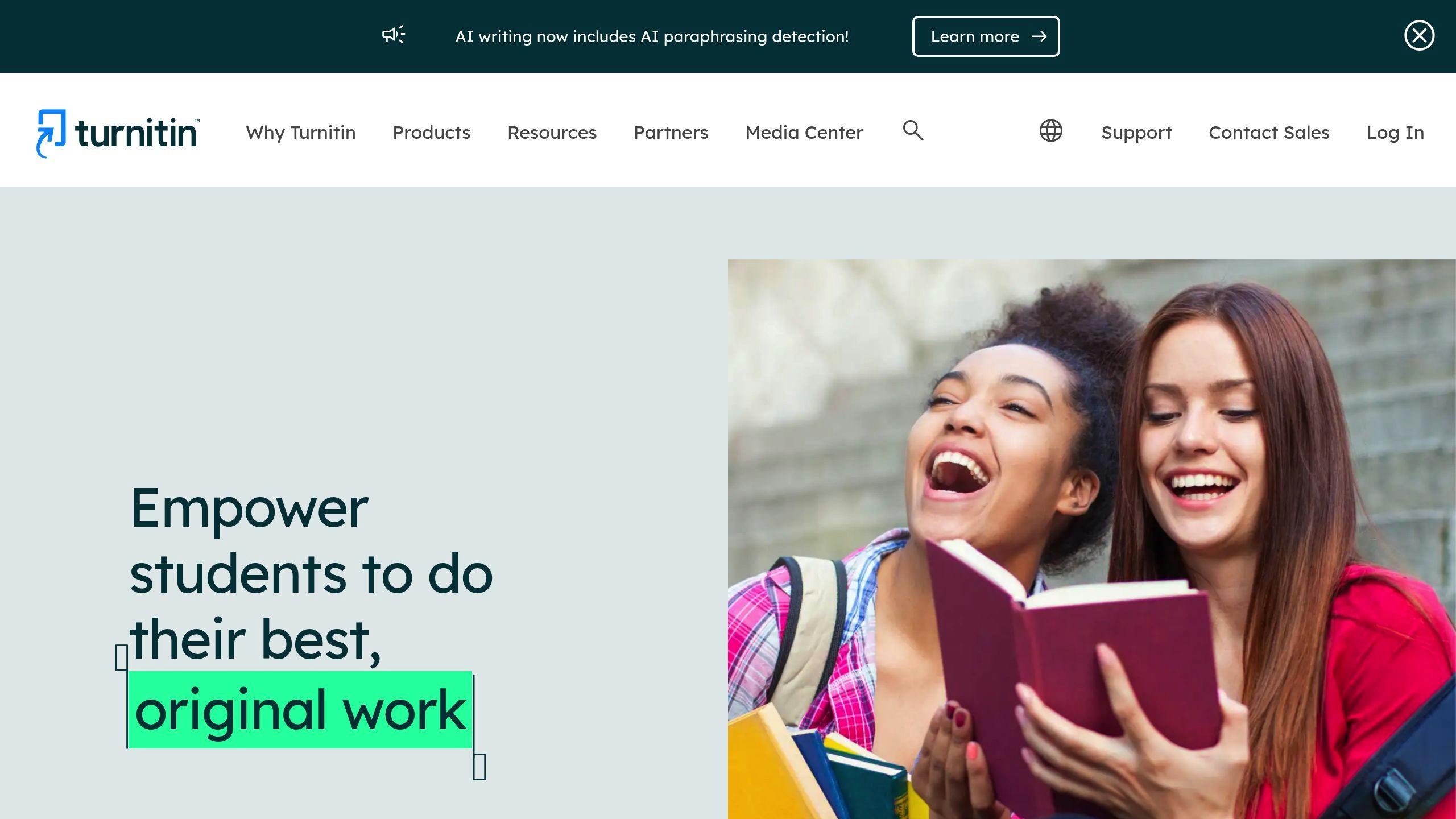
Turnitin can detect AI-generated text, including content from ChatGPT and other LLMs, using advanced algorithms and a color-coded confidence score system:
- Red: High likelihood of AI-generated content
- Yellow: Moderate likelihood
- Blue: Low likelihood
Key facts about Turnitin's AI detection in 2025:
- Accuracy: 98-100% for standard AI text, but lower for heavily edited or hybrid (AI-human) content.
- Features: Combines AI detection with plagiarism analysis, offering educators a unified tool.
- Limitations: False positives may occur, especially in formal or technical writing.
For students, ethical AI use includes generating ideas or conducting research with proper citation, while directly submitting AI-generated work is flagged as misconduct.
Educators are advised to pair AI detection with manual review to ensure fairness.
Quick Comparison of AI Detection Tools:
| Feature | Turnitin | Detecting-AI.com | Other Tools |
|---|---|---|---|
| Primary Function | Plagiarism + AI Detection | Plagiarism + AI Detection | Varies by Platform |
| AI Detection Accuracy | 98-100% (standard AI text) | 99%+ (e.g., GPT-4 content) | Platform-dependent |
| Integration | School Systems | Standalone Web Tool | Usually Standalone |
| Additional Features | Similarity Reports | Fact Checking | Platform-specific |
Turnitin’s tools continue to evolve, helping institutions maintain academic integrity in an AI-driven world. Use them alongside clear policies and assignments that encourage originality.
How Turnitin Identifies AI Text

How the Detection System Works
Turnitin's AI detection system uses advanced machine learning and language analysis to spot patterns that are specific to AI-generated text . Unlike traditional plagiarism checks, this system looks at writing traits that separate machine-created content from human writing.
By analyzing text patterns, evaluating style consistency, and pinpointing areas where AI and human writing are combined, the system can detect AI-generated content with precision . This includes identifying outputs from cutting-edge tools like GPT-4.
AI Models Supported
As of 2025, Turnitin has enhanced its system to recognize content from a variety of AI writing tools. It can accurately detect text produced by GPT-4, mixed AI-human content, and other large language models. This ensures reliable detection across different platforms .
Extensive testing has shown that Turnitin performs well in practical applications, providing dependable results.
Real-World Examples
In recent evaluations, Turnitin achieved 100% accuracy in identifying AI-generated content across multiple scenarios . Its confidence scoring system offers clear insights into the likelihood of AI involvement.
One study highlighted that around 11% of reviewed papers contained significant AI-generated content (20% or more). Turnitin successfully flagged all of these cases . These findings underscore its importance in maintaining academic integrity as AI tools continue to evolve.
Turnitin's Detection Accuracy
Success Rates and Errors
Turnitin's AI detection system boasts an accuracy rate of 98-100% when identifying text from widely-used AI models like ChatGPT and GPT-4 . However, false positives can still happen, particularly with formal or technical writing that mimics AI-like traits. These traits might include a standardized structure, repetitive phrasing, or overly formal language . Because of this, educators need to carefully examine flagged content to ensure students aren't unfairly penalized. These high accuracy rates underline Turnitin's role in supporting academic integrity.
Detecting Modified AI Text
Spotting heavily edited AI-generated content is a tougher task. To address this, Turnitin analyzes style consistency across different parts of a document, looking for patterns in writing style . While this method helps in identifying altered AI content, its accuracy drops significantly when the text has been extensively edited by a human.
Missed Detections
Even with its strong capabilities, some content can slip through undetected:
- Text from advanced AI models or heavily edited AI content
- Mixed writing that combines AI and human input
- Complex or highly specialized technical writing
Educators are encouraged to pair Turnitin's automated detection with other verification methods .
| Detection Scenario | Accuracy Level |
|---|---|
| Standard AI Text | 98-100% |
| Modified AI Content | Variable |
| Hybrid Content | Lower accuracy |
This demonstrates the importance of blending automated tools with human judgment to ensure fair and thorough evaluations. Such a combined approach is especially important for reviewing complex or questionable submissions.
AI Detection Tools Compared
Turnitin vs Specialized Tools
Turnitin combines AI detection with its plagiarism-checking features, offering a dual-purpose tool for educators. On the other hand, platforms like Detecting-AI.com focus solely on identifying AI-generated content. This single focus allows tools like Detecting-AI.com to pick up on subtle AI-generated patterns that broader tools, such as Turnitin, might miss.
These differences help educators choose tools that best fit their institution's academic integrity needs. Below is a comparison of key features between Turnitin and other AI detection tools.
Tool Comparison Chart
| Feature | Turnitin | Detecting-AI.com | Other Specialized Tools |
|---|---|---|---|
| Primary Function | Plagiarism + AI Detection | Plagiarism + AI Detection | Varies by Platform |
| Integration | Compatible with School Systems | Standalone Web Tool | Usually Standalone |
| Processing Capabilities | Standard speed, varies by institution | Instant detection, 160,000 chars (paid) | Varies by platform |
| Additional Features | Similarity Reports, Grade Marking | Plagiarism Check, Fact Checker | Platform Specific |
Plagiarism Check Integration
Turnitin’s dual-functionality approach simplifies the review process for educators by combining AI detection and plagiarism analysis into a single report. Here’s why this integrated system is beneficial:
- Streamlined Review: Teachers can evaluate both AI-generated content and plagiarism indicators in one place.
- Comprehensive Analysis: It assesses both source matching and AI-generation patterns, providing detailed insights.
- Seamless Integration: Designed to work with existing school platforms for smoother adoption.
Turnitin also separates metrics for AI detection scores and similarity percentages, helping educators address distinct academic integrity concerns. This combined approach equips institutions with the tools they need to maintain high academic standards in a world increasingly influenced by AI .
sbb-itb-207a185
Guidelines for Users
Tips for Teachers
To use AI detection tools effectively and maintain academic integrity, educators should combine preventive strategies with thoughtful use of Turnitin's AI detection feature.
Create assignments that reduce the temptation to misuse AI:
- Assign personal reflections tied to specific class discussions.
- Require staged submissions that show progress over time.
- Include tasks based on unique course materials or recent events.
When reviewing student work, take a thorough approach:
- Compare flagged sections with earlier drafts or previous submissions.
- Hold brief conversations with students about their writing process, if necessary.
- Combine AI detection results with a manual review to ensure accuracy.
Student Guidelines
Students also have a responsibility to uphold academic integrity while using AI tools appropriately.
| Acceptable AI Use | Unacceptable AI Use |
|---|---|
| Using AI for research and exploring topics | Copying AI-generated text directly |
| Generating ideas with proper citation | Relying on AI to write entire assignments |
| Getting grammar and structure suggestions | Submitting AI-generated content as original work |
When submitting work for Turnitin analysis, students should:
- Keep detailed records of their writing process and sources.
- Clearly document any valid AI use for research purposes.
- Use tools like Detecting-AI.com to check their work before submission.
Turnitin's AI detection is just one part of a larger strategy to promote academic integrity. Students should see it as a learning tool that helps maintain high standards, not as a hurdle to bypass.
AI Detection: Next Steps
Detection Updates
Turnitin continues to refine its tools to keep up with the fast-paced evolution of AI, ensuring academic integrity remains a priority. The platform is improving its ability to spot patterns from advanced AI models like GPT-4 and beyond .
Here’s what’s new:
- Stronger algorithms to recognize advanced AI writing techniques
- Better detection of AI-generated content that has been heavily edited
- Increased accuracy in differentiating between human and AI writing
In addition, Detecting-AI.com offers complementary features and frequent updates, providing specialized tools that work alongside Turnitin’s broader academic solutions to support integrity efforts.
AI and Academic Standards
As detection tools advance, academic institutions need to adapt their policies to address the ethical use of AI in education. Combining these policies with tools like Turnitin creates a stronger framework for maintaining integrity.
| Approach | Implementation | Expected Outcome |
|---|---|---|
| Policy Integration | Set clear rules for AI usage | Standardized practices |
| Assignment Design | Focus on critical thinking | Less reliance on AI |
| Detection Tools | Use multiple solutions | Better verification |
| Student Education | Teach ethical AI practices | Improved compliance |
Educators should stay updated on AI detection advancements by consulting official updates and third-party reviews . Being informed helps institutions apply these tools effectively while reinforcing integrity policies.
Looking ahead, education must balance AI’s potential with its challenges by:
- Encouraging ethical AI usage while upholding academic values
- Prioritizing originality and critical thinking in assignments
- Offering clear guidance on when and how AI tools can be used
- Ensuring detection tools are accessible to both students and educators
As AI detection evolves, institutions must align their policies with these advancements to support authentic learning experiences.
Conclusion
AI Detection Tools in Education
By 2025, Turnitin has become a key player in supporting academic integrity, offering institutions tools to detect AI-generated content effectively . Paired with platforms like Detecting-AI.com, which provides additional verification options, these tools create a solid system for upholding academic standards.
AI detection tools have transformed how academic integrity is maintained. They help institutions navigate the intersection of advancing technology and educational values while recognizing AI's increasing presence in academia.
To get the most out of these tools, both educators and students need to understand their capabilities, limitations, and how to use them effectively.
Quick Reference Guide
| Aspect | Key Points |
|---|---|
| Detection Capabilities | Accurate but not foolproof; flagged content requires manual review |
| Implementation Strategy | Regular updates, clear usage guidelines, and seamless integration |
| Student Support | Provide resources for ethical AI use and proper citation practices |
| Best Practices | Use detection tools alongside human review; encourage open discussions about AI |
The success of AI detection tools relies on thoughtful implementation and clear understanding. These tools should be seen as supportive aids, not as the ultimate authority on academic integrity . By fostering conversations about AI's role and setting clear policies, institutions can better handle the challenges AI brings to education.
For the best outcomes, combine Turnitin's detection features with regular updates on AI advancements and consistent enforcement of policies. This ensures academic integrity remains intact while adapting to technological changes in education .